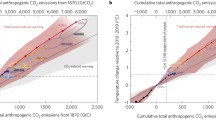Abstract
This paper provides an overview of new emission mitigation scenarios that lead to stabilization of atmospheric CO2 concentrations, presented in this Special Issue. All of these scenarios use as their baselines the new IPCC scenarios published in the IPCC Special Report on Emission Scenarios (SRES), which quantify a wide range of future worlds. This means the new mitigation and stabilization scenarios are based on a range of future development paths that have fundamental implications for future emissions reduction strategies. Here, we refer to these new scenarios as “Post-SRES” mitigation scenarios. In addition to providing an overview of these new scenarios, this paper also assesses the implications that emerge from a range of alternative development baselines for technology and policy measures for reducing future emissions and stabilizing atmospheric CO2 concentrations. Nine modeling teams have participated in this joint effort to quantify a wide range of mitigation and stabilization scenarios. The nine modeling approaches involve different methodologies, data, regional aggregations and other salient characteristics. This pluralism of approaches and alternative baselines serves to cover some of the uncertainties embedded across a range of different mitigation and stabilization strategies. At the same time, several common trends and characteristics can be observed across the set of Post-SRES scenarios. First, the different baseline “worlds” described in the SRES scenarios require different technology/policy measures to stabilize atmospheric CO2 concentrations at the same level. Second, no one single measure will be sufficient for the timely development, adoption and diffusion of mitigation options to achieve stabilization. Third, the level of technology/policy measures in the beginning of the 21st century that would be needed to achieve stabilization would be significantly affected by the choice of development path over next one hundred years. And finally, several “robust policy options” across the different worlds are identified for achieving stabilizations.
Similar content being viewed by others
References
Alcamo J, Bouwman A, Edmonds J, Gruebler A, Morita T, Sugandhy A (1995) An Evaluation of the IPCCIS92 Emission Scenarios. In: Climate change 1994, radiative forcing of climate change and an evaluation of the IPCC IS92 emission scenarios. Cambridge University Press, Cambridge
Bollen J, Manders T, Timmer H (2000) The benefits and costs of waiting—early action versus delayed response in the post-SRES stabilization scenarios. Environmental Economics and Policy Studies 4:143–158
IPCC (1990) Report of the Expert Group on Emission Scenarios
IPCC (1995) Climate change, the science of climate change, contribution of Working Group 1 to the Second Assessment Report of the Intergovernmental Panel on Climate Change. Cambridge University Press, Cambridge
Jiang K, Morita T, Masui T, Matsuoka Y (2000) Global long-term GHG mitigation emission scenarios based on AIM. Environmental Economics and Policy Studies 4:239–254
Joos F. et al (1996) An efficient and accurate representation of complex oceanic and biospheric models of anthropogenic carbon uptake. Tellus 48B:389–417
Kverndokk S, Lindholt L, Rosendahl KE (2000) Stabilization of CO2 concentrations: mitigation scenarios using the Petro model. Environmental Economics and Policy Studies 4:195–224
Legett J, Pepper W, Swart R (1992) Emission scenarios for IPCC: an update. In: Houghton J, Callander B, Varney S (eds) Climate change 1992, supplementary report to the IPCC scientific assessment, Cambridge University Press, Cambridge
Matsuoka Y (2000) Development of a stabilization scenario generator for long-term climatic assessment. Environmental Economics and Policy Studies 4:255–265
Mori S (2000) Effects of carbon emission mitigation options under carbon concentration stabilization scenarios. Environmental Economics and Policy Studies 4:125–142
Nakicenovic N, et al (IPCC) (2000) Special report on emission scenarios. Cambridge University Press, Cambridge
Pitcher H (2000) An assessment of mitigation options in a sustainable development world. Environmental Economics and Policy Studies 4:173–193
Rana A, Morita T (2000) Scenarios for greenhouse gas emissions mitigation: a review of modeling of strategies and policies in integrated assessment models. Environmental Economics and Policy Studies 4:267–289
Riahi K, Roehrl RA (2000) Robust energy technology strategies for the 21st century—carbon dioxide mitigation and sustainable development. Environmental Economics and Policy Studies 4:89–123
Sankovski A, Barbour W, Pepper W (2000) Climate change mitigation in the regionalized world. Environmental Economics and Policy Studies 4:225–237
Yamaji K, Fujino J, Osada K (2000) Global energy system to maintain atmospheric CO2 concentration at 550 ppm. Environmental Economics and Policy Studies 4:159–171
Author information
Authors and Affiliations
Corresponding author
About this article
Cite this article
Morita, T., Nakićenović, N. & Robinson, J. Overview of mitigation scenarios for global climate stabilization based on new IPCC emission scenarios (SRES). Environ Econ Policy Stud 3, 65–88 (2000). https://doi.org/10.1007/BF03354031
Received:
Accepted:
Published:
Issue Date:
DOI: https://doi.org/10.1007/BF03354031




